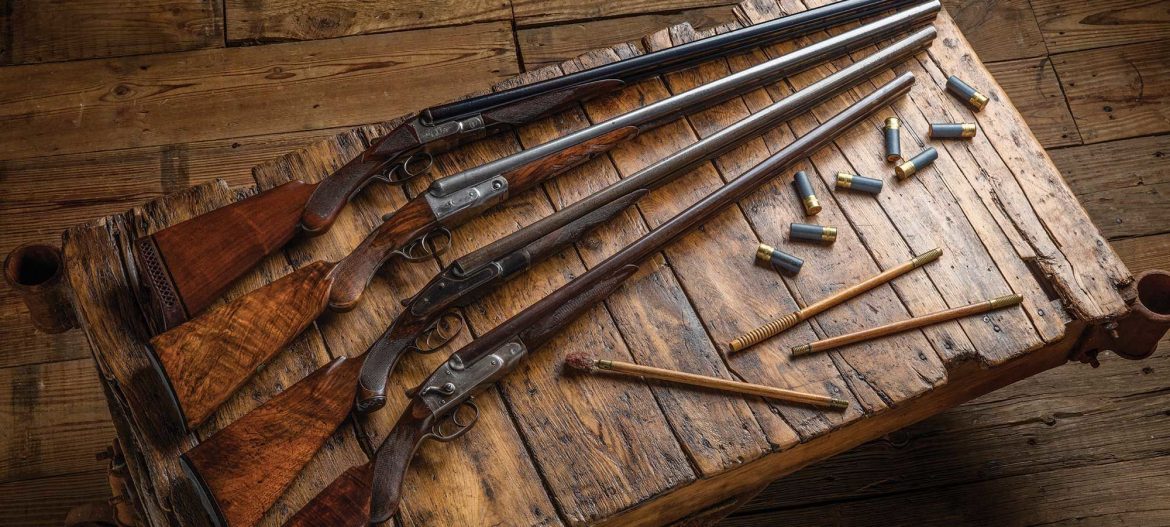
One day in the summer of 1985, I wandered into a bookshop and found, tucked away on a shelf marked “Sports,” a book by Michael McIntosh. It was The Best Shotguns Ever Made in America, published in 1981, and it told the story of the legendary American side-by-sides: Parker, A.H. Fox, Ithaca, L.C. Smith, Lefever, and the Winchester 21.
The book was drawn from a series of magazine articles written in the 1970s, when McIntosh worked for the Missouri Conservationist. At that time, all but the Winchester 21 were out of production. For such a slim volume (just 185 pages), the book had an enormous impact. By recounting the stories of seminal, forgotten guns, it reignited interest in the American side-by-side in the hearts of many more. My own semi-dormant love of side-by-sides was rekindled.
Almost 20 years later, I was shooting at a skeet club with a friend who was also a lover of side-by-sides, when another member showed up carrying a Stevens 311, a long-barreled brute of a gun intended originally for geese at long range, or maybe grizzlies up close. A skeet gun it was not.

Double Vision: Most affordable side-by-sides are waterfowl guns, like the 12-gauge Baker (right), with 30-inch barrels. True upland guns, like the 26-inch 16-gauge Ithaca, are harder to find.
“You guys are always talking about how great side-by-sides are,” he said, “So I thought I’d try one.” We shot a round of skeet with exactly the results you might expect. Afterward, he shook his head. “Sorry, fellas, I just don’t see it.” It was no wonder. These two moments tie together and tell a lot about the American side-by-side market in general. It’s filled with contradictions.
In the years between the two, a lot happened: That reignited interest in side-by-sides of all stripes took off. Talk of resurrecting the great ones became reality: The Parker Reproduction of the 1980s was followed by the A.H. Fox in the early ’90s, and a few years later, the Ithaca Classic Double.
Meanwhile, prices of original Parkers in every grade soared, and they became a seriously hot item for collectors. The Fox, Ithaca, and “Sweet Elsie” (L.C. Smith) were pulled along in the slipstream. Magazines sprang up devoted to classic shotguns, along with side-by-side clubs, national shows, and shooting events. It appeared, for a time, that the side-by-side was back for good. However, appearances can be deceiving.
With hindsight, that couple-decades-long “renaissance” seems to have been a last flicker of interest before the side-by-side ran aground, yet again, on the shoals of economics and labor costs. Interest, while intense among the few, was just too small to support an industry.
However, Tony Galazan managed to build a substantial company on the back of that interest. Connecticut Shotgun Manufacturing (CSMC), in New Britain, began as a dealer specializing in old Parkers, cashed in on the explosion of interest in the ’90s, and brought the A.H. Fox back into production. Today, CSMC makes a boxlock side-by-side of its own design (the RBL) and has the rights to the Fox, Parker, and Winchester 21. He is also producing a new Fox shotgun for Savage Arms. No one in America knows more about the American side-by-side, than Tony Galazan.
Asked what he sees as the major obstacle to the sustained return of the American side-by-side, Galazan’s answer was not cost of production, rather surprisingly, but lack of demand.
“In the last five years, particularly, interest in the U.S. has centered less on the great old guns, and more on black guns,” he told me.
Looking back, it seems the great interest in side-by-sides that blossomed between 1985 and 2005 had a lot to do with nostalgia. Baby boomers, whose fathers and grandfathers shot such guns, had made some money and were now interested in acquiring a “good old gun like Dad used.”
The Parker Reproduction attempted to ride the wave of this interest, with guns made in Japan whose parts were interchangeable with the originals. They were produced in the most desirable gauges (20 and 28), in higher grades, with commensurate prices. The benchmark price was around…





